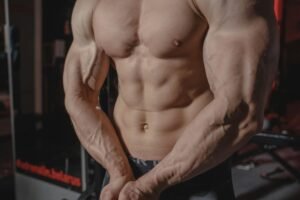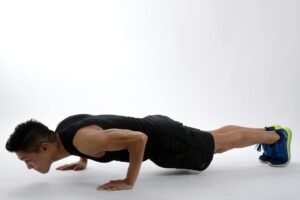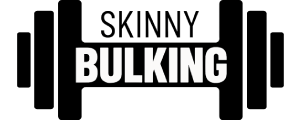A well-defined and muscular chest is not only aesthetically pleasing but also a sign of strength and power. Whether you are a bodybuilder, athlete, or simply someone who wants to improve their overall fitness, building a stronger and bigger chest is an important goal. However, achieving a perfect chest is not an easy task, and it requires a lot of hard work and dedication. But don’t worry, in this post, we will share with you 10 proven ways to build bigger and stronger chest muscles. From focusing on compound exercises and increasing the weight, to incorporating different types of training and following a proper diet plan, we’ll give you all the tips and tricks you need to attain the perfect chest you’ve always wanted. Get ready to put in the work and see the results with these 10 effective strategies.
1. Why the chest is important for overall fitness

Image: pexels
The chest muscles are among the most visible muscles in the body, and that’s why many fitness enthusiasts focus on building a bigger and stronger chest. However, the chest muscles – specifically the pectoralis major and minor muscles – play a vital role in overall fitness and physical health.
The chest muscles are responsible for many movements that we perform daily, such as pushing, pulling, lifting, and carrying. For athletes, having a strong chest is essential for sports that require upper body strength, like football, basketball, and wrestling. Moreover, a well-developed chest can also improve posture and reduce the risk of shoulder injuries.
Aside from the physical benefits, working out the chest muscles can also have positive effects on mental health. A study published in the Journal of Strength and Conditioning Research found that resistance training, including chest workouts, can reduce anxiety and depression symptoms and improve overall mood.
In summary, building a strong and well-defined chest is not only essential for achieving aesthetic goals but also for overall physical and mental health. With proper training and nutrition, you can achieve a bigger and stronger chest that will enhance your fitness and well-being.
2. The anatomy of the chest muscles
Before we even begin to discuss how to build bigger and stronger chest muscles, let’s take a look at the anatomy of the chest muscles.
The chest muscles, also known as the pectoralis major and pectoralis minor, are located in the upper torso and are responsible for movements such as pushing, pulling, and rotating the arms.
The pectoralis major is the larger of the two chest muscles and is divided into two parts: the clavicular head and the sternal head. The clavicular head is located at the upper part of the chest and is responsible for lifting the arms and bringing them across the body. The sternal head is located at the lower part of the chest and is responsible for pulling the arms down and across the body.
The pectoralis minor is located underneath the pectoralis major and is responsible for stabilizing the shoulder blade.
Understanding the anatomy of the chest muscles is essential to targeting and isolating these muscles during workouts, which will lead to greater muscle growth and strength gains. By targeting specific parts of the chest muscles, you can customize your workout routine to maximize your results and achieve a more defined and sculpted chest.
3. The 10 best exercises for building chest muscles
When it comes to building bigger and stronger chest muscles, there are a variety of exercises to choose from. However, not all chest exercises are created equal. Some exercises may target the upper chest, some the lower chest, and some may target both. So what are the best exercises for building chest muscles?
1. Barbell Bench Press – This classic exercise targets the entire chest and is a great compound exercise.
2. Dumbbell Bench Press – Similar to barbell bench press, but with dumbbells, which allows for a greater range of motion and can help to correct muscle imbalances.
3. Incline Barbell Bench Press – This targets the upper chest and is a great way to develop a well-rounded chest.
4. Incline Dumbbell Bench Press – Similar to incline barbell bench press, but with dumbbells.
5. Decline Barbell Bench Press – This targets the lower chest and can help to develop a more defined chest.
6. Decline Dumbbell Bench Press – Similar to decline barbell bench press, but with dumbbells.
7. Chest Flyes – This exercise targets the chest muscles and can be performed with dumbbells or a cable machine.
8. Push-Ups – A classic exercise that targets the entire chest and can be done anywhere.
9. Cable Crossovers – This exercise targets the chest muscles and can be performed with a cable machine.
10. Dips – This exercise targets the chest, triceps, and shoulders and can be performed using parallel bars or a dip machine.
Incorporating a variety of these exercises into your chest workout routine can help you to build bigger and stronger chest muscles. It’s important to remember to use proper form and gradually increase weight and intensity to avoid injury and promote muscle growth.
4. How to correctly perform the bench press
The bench press is one of the most popular exercises for building bigger and stronger chest muscles, but it’s important to perform this exercise correctly to avoid injuries and maximize the benefits.
To perform a proper bench press, lie on a flat bench with your feet flat on the ground and your back pressed against the bench. Grasp the barbell with a wide, overhand grip and slowly lower it down to your chest, making sure to keep your elbows tucked in close to your body.
As you lower the bar, inhale deeply and then exhale forcefully as you push the bar back up to its starting position. Your chest, shoulders, and triceps should be working together to lift the weight.
It’s important to avoid arching your back or bouncing the bar off your chest, as this can put unnecessary strain on your lower back and increase the risk of injury. Start with a weight that you can comfortably lift for 8-10 reps and gradually increase the weight as your strength improves.
You can also vary your grip width and angle to target different areas of your chest muscles. For example, a wider grip will emphasize the outer chest muscles, while a narrower grip will target the inner chest muscles.
5. The benefits of push-ups for chest development

Image: pexels
Push-ups are one of the most basic yet effective exercises for chest development. It requires no equipment and can be done anywhere, making it an ideal exercise to add to your workout routine.
Push-ups work on several muscles, including the chest, triceps, shoulders, and core. It is a compound exercise, meaning that it works on multiple muscle groups at the same time. This results in a more efficient workout that helps build strength and muscle mass faster.
Push-ups are also great for improving upper body stability and balance. It engages the stabilizer muscles in your shoulders, arms, and core, which help improve your overall posture and reduce the risk of injury.
Another benefit of push-ups is that it can be easily modified to suit your fitness level. If you’re just starting, you can start with wall push-ups or knee push-ups, and gradually progress to full push-ups as you get stronger.
Incorporating push-ups into your chest workout routine is a great way to add variety and challenge to your workout. With consistent practice, you’ll see improvements in your chest strength and size in no time.
6. The role of dumbbells and barbells in chest training
Dumbbells and barbells are essential equipment for anyone looking to build bigger and stronger chest muscles. They offer a wide range of exercises that can be done with varying weights, and they help target different areas of the chest.
Barbell bench press is one of the most popular exercises for building chest muscles. This exercise targets the major muscles in the chest, including the pectoralis major and minor, as well as the triceps and shoulders. It is important to use proper form and technique when doing barbell bench press to avoid injury and to get the most out of your workout.
Dumbbells can also be used to target the chest muscles from different angles. Flat dumbbell bench press is similar to barbell bench press but allows for a greater range of motion, which can help build better muscle definition. Incline dumbbell bench press targets the upper chest muscles, while decline dumbbell bench press targets the lower chest muscles.
Another great exercise that can be done with dumbbells is the dumbbell fly. This exercise targets the outer chest muscles and helps to create a wider, more defined chest. It is important to use a weight that is appropriate for your fitness level and to focus on proper form and technique to avoid injury.
In summary, dumbbells and barbells are essential tools for anyone looking to build bigger and stronger chest muscles. They offer a wide range of exercises that can be tailored to your fitness level and help you target different areas of the chest for maximum results.
7. How to incorporate cable exercises into chest workouts
Cable exercises are a great way to incorporate variety into your chest workouts. The best thing about cable exercises is that they allow you to maintain constant tension on your chest muscles throughout the movement, which is crucial for building muscle mass and strength.
One way to incorporate cable exercises into your chest workouts is by doing cable crossovers. To perform this exercise, stand in the middle of a cable machine and grab the handles with both hands. Step forward slightly and lean forward from the waist, keeping your core engaged and your back straight. With a slight bend in your elbows, pull the cables across your body until your hands meet in front of your chest. Slowly release and repeat for desired reps.
Another cable exercise that targets the chest is the low-to-high cable fly. To do this exercise, adjust the cable to the lowest position and grab the handles with both hands. Stand facing away from the cable machine and take a few steps forward so that there is tension on the cables. Keep your core engaged and your back straight as you bring your arms up and in front of your chest, keeping a slight bend in your elbows. Slowly release and repeat for desired reps.
Incorporating cable exercises into your chest workouts is a great way to challenge your muscles in new ways and break through plateaus. Just make sure to use proper form and start with lighter weight to avoid injury.
8. The importance of progressive overload in chest training
When it comes to building bigger and stronger chest muscles, one of the most important principles to keep in mind is progressive overload. This means gradually increasing the amount of weight you use or the number of reps you perform over time. By doing this, you challenge your muscles more and more, which stimulates them to grow and become stronger.
One way to implement progressive overload in your chest training is by using compound exercises like the bench press, incline press, and dips. These exercises allow you to lift heavy weights and work multiple muscle groups at once, which is essential for maximum growth and strength gains.
Another way to incorporate progressive overload is by varying your reps and sets. For example, you might start with 3 sets of 8 reps for a particular exercise, and then gradually increase to 4 sets of 10 reps over the course of a few weeks. This constant progression will keep your chest muscles challenged and growing.
It’s important to note that progressive overload should be implemented gradually and safely. If you increase the weight too quickly or use bad form, you risk injury and setbacks in your training. Remember to focus on proper form and technique, and increase the weight or reps gradually over time to see the best results.
9. Tips for preventing injury while training chest muscles
Chest muscles are one of the most prominent muscle groups in the body, making it a popular area to train. However, it’s important to keep in mind that training these muscles can also lead to injuries if not done correctly. Therefore, it’s essential to follow some tips to prevent injury while training chest muscles.
First and foremost, always warm up before starting your chest workout. This can be done with some light cardio, stretching, or by doing a few sets with lighter weights. Warming up helps increase blood flow to your muscles, making them more pliable and less prone to injury.
Secondly, focus on your form. Incorrect form can lead to injuries, so make sure you’re performing each exercise properly. Use a weight that is challenging but allows you to maintain good form throughout the exercise.
Thirdly, avoid overtraining. Chest muscles are a large muscle group, but they still need time to recover. Don’t train them every day, and make sure to have rest days in between workouts. Overtraining can lead to injuries such as strains or tears.
Fourthly, listen to your body. If you experience any pain or discomfort, stop the exercise immediately. Pushing through pain can lead to further injuries.
Lastly, consider working with a personal trainer or fitness professional to ensure you’re training your chest muscles safely and effectively. They can help you develop a workout plan that is tailored to your needs and goals while minimizing the risk of injury.
Incorporating these tips into your chest workout routine will help you prevent injuries and achieve your goals of building bigger and stronger chest muscles.
10. The role of nutrition in building chest muscles

Image: unsplash
When it comes to building chest muscles, nutrition plays a crucial role. It’s important to have a balanced diet that includes all essential nutrients, vitamins, and minerals that are necessary for muscle growth and recovery.
Protein is the most important nutrient for building muscle, and it’s recommended that you consume at least 1 gram of protein per pound of body weight. This can come from various sources such as lean meats, fish, eggs, dairy, and plant-based protein sources like tofu or legumes.
Carbohydrates are also important as they provide the energy needed for intense workouts. Complex carbs like brown rice, quinoa, and sweet potatoes are ideal sources of energy.
Healthy fats are also essential for muscle growth and recovery. Sources of healthy fats include avocados, nuts, and olive oil.
It’s important to avoid processed and junk foods that are high in sugar, salt, and unhealthy fats, as they can hinder muscle growth and recovery. Additionally, staying hydrated is important for overall health and muscle growth.
In conclusion, a well-balanced diet that includes protein, complex carbohydrates, healthy fats, and plenty of water is essential for building bigger and stronger chest muscles. It’s important to consult with a registered dietitian or nutritionist to make sure that your diet is tailored to your specific needs and goals.







Leave a Reply